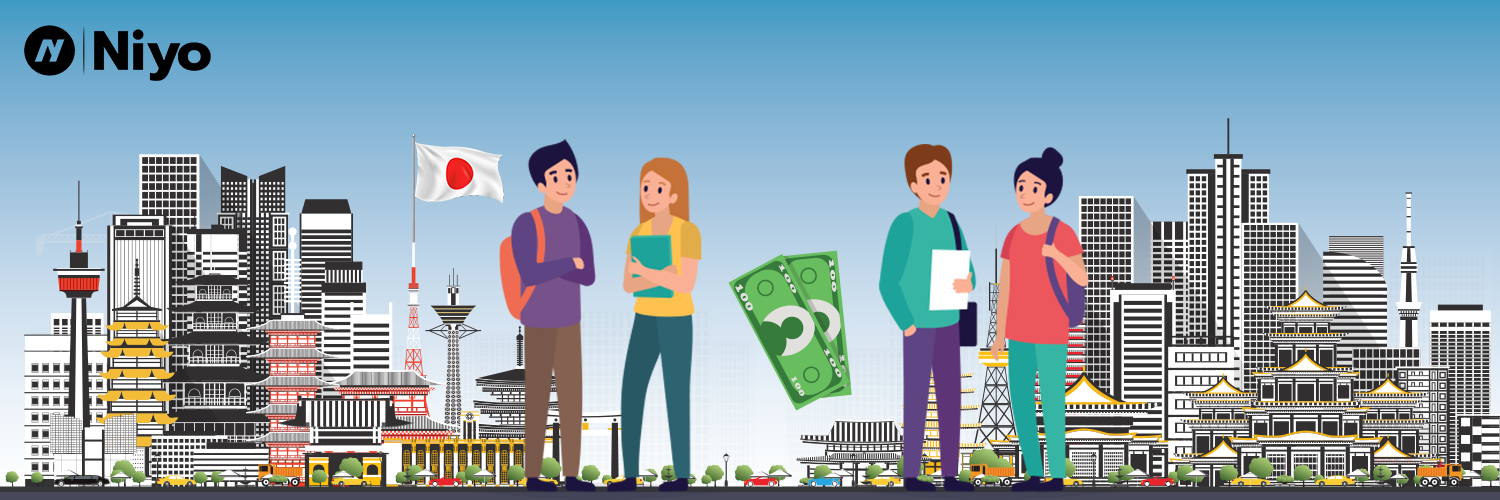
Cost of Living in Japan for Indian Students in 2024
Cost of Living in Japan for Indian Students in 2024
[playht_player width=“100%” height=“90px” voice=“Noah”]
Introduction
Thinking about studying abroad? Exploring a new culture different from yours can be exciting. Living in Japan as an Indian is like entering a new way of life, which can be absolutely interesting!
The famous land of the rising sun, Japan, is an island country on the east coast of Asia. There is no denying that living in Japan will make everyone smile, as it is the most urbanised and densely populated country in the world.
There are various benefits of studying abroad for Indians, and we believe you are here to understand what living in Japan as an Indian could be like and the average cost of living in Japan. Deep-dive into answering all your questions on the cost of living in Japan for Indian students and hope it will put your mind at ease and help you make a well-informed decision about the cost of studying in Japan. So, equip yourself with insights, plan your transition smoothly, and embrace your Japanese adventure with open arms!
Cost of Living in Japan for Indian Students in 2024: An Overview
Japan has a comparatively low cost of living compared to other countries such as America, London, etc. The estimated living cost in Japan will be around 280,000 - 600,000 YEN. It’s important to note that this is just an estimate. The actual cost of living in Japan can vary depending on several factors, such as which city you choose to live in, like Tokyo, Kawasaki, Yokohama, Chiba, Hiroshima, Kitakyushu, etc. So here is an estimated cost of living in Japan for Indian students.
| Factor | Average Cost Per Month (YEN) | Range |
| Accommodation | fff;">30,000 | <td style=“background-color:|
| Food & Groceries | <td style=“background-color:||
| Transportation | <td style=“background-color:||
| Household Bills | <td style=“background-color:||
| Mobile Phone | <td style=“background-color:||
| Entertainment & Leisure | <td style=“background-color:||
| Miscellaneous | <td style=“background-color:||
| Insurance & Medical | <td style=“background-color:
These estimates give you an understanding of the average living expenses in Japan. Remember that the costs can differ greatly depending on which city you decide to live in. When thinking about the cost of living in Japan, not including expenses, Kyushu city generally comes out to around 73,000 YEN per month, while the cost of living in Tokyo for Indians averages around 1,08,000 YEN.
Now let’s dive into the specifics of each aspect of the cost of living in Japan for Indian students starting with accommodation.
1. Accommodation
The cost of accommodation influences the cost of living in Japan for Indian students. It tends to be quite expensive anywhere you are in the world. Whether students stay in university-provided hostels or rent a room can greatly impact their expenses. Here’s an overview of living expenses in Japan regarding student accommodation:
| Type of Accommodation | Average Rent per Month (YEN) | Notes |
| Dormitory Accommodation | fff;">12,000 - 25,000 | <td style=“background-color:|
| Shared Apartment | <td style=“background-color:||
| Studio Apartment | <td style=“background-color:||
| 1-Bedroom Apartment | <td style=“background-color:
Dormitory housing is the arrangement where individuals or groups share a room with beds. Depending on the university policies, shared or private bathrooms may be available.
Additionally, opting for private accommodations in Japan can be quite costly for students. Choosing dormitory housing is a choice that allows you to be part of a community and provides motivation to excel academically and make the most out of your student life in Japan.
Now, let’s take a look at the average cost of rent in Japan in its various popular student cities.
| City | Average Cost of Living Per Month (YEN) |
| Tokyo | ffff;">108,000 |
| Yokohama | <td style=“background-color:|
| Osaka | <td style=“background-color:|
| Sapporo | <td style=“background-color:|
| Kobe | <td style=“background-color:
2. Food and Groceries
Food cost in Japan plays an important role in determining the cost of living in Japan for Indian students. One good news is that you can find Indian food in cities like Tokyo, Osaka and Yokohama, catering to both locals and expats. You can savour dishes such as curry, biryani, samosas, and naan; however, it’s worth noting that prices may be slightly higher compared to those in India.
Additionally, Indian grocery stores in Japan are growing in popularity, offering ingredients like spices, lentils, and rice for those who prefer cooking at home. While prices may be slightly elevated compared to India, it provides a way to enjoy the flavours you’re familiar with while also saving money.
It’s important to note that universities in Japan generally do not include food expenses in their plans. Students are responsible for managing their meals. Below is the table to give you an idea of the cost of food and groceries in Japan:
| Particulars | Cost (YEN) |
| fff;">Milk (regular - 1 litre) | <td style=“background-color:|
| 633.88 | |
3. Transportation
The transportation costs in Japan can vary depending on the distance between your university and place of residence and how much you travel around the city.
| Mode of Transport | Cost | Notes |
| One-way Ticket (Local Transport): | fff;">220.00 YEN | <td style=“background-color:|
| Monthly Pass (Regular Price): | <td style=“background-color:||
| Toyota Corolla Sedan 1.6 l, 97kW Comfort (New Car): | <td style=“background-color:||
| Gasoline (1 liter): | <td style=“background-color:||
| Volkswagen Golf 1.4 l, 90 KW Trendline (New Car): | <td style=“background-color:||
| Taxi 1 hour Waiting (Normal Tariff): | <td style=“background-color:||
| Taxi 1 km (Normal Tariff): | <td style=“background-color:||
| Taxi Start (Normal Tariff): | <td style=“background-color:
4. Household Bills
If you choose to live in an apartment or share a room with friends, you might have utility expenses such as, gas, water, and electricity bills, wifi services, television, mobile expenses, and more.
But most of these amenities are conveniently available in case you choose to live within the university premises. The cost for these utilities is typically already included in the tuition fees for education programs such as bachelor’s or master’s degrees.
Here’s a brief overview of the utility bills to consider in the cost of studying in Japan for Indian students:
| Option | Average Cost Per Month (YEN) |
| fff;">Pocket Wifi device | <td style=“background-color:|
5. Entertainment
Being a student helps to include entertainment expenses in your budget to cover both your fitness and other entertainment-related expenses. Here’s what you can expect:
| Entertainment Option | Average Cost |
| fff;">Fitness Club, Monthly Fee for 1 student: | <td style=“background-color:|
Note that your average living expenses in Japan may increase due to activities that are not included in our previous discussions.
International students often engage in pursuits beyond their studies, such as music lessons, language learning, sports and more. Therefore, it is important to take these expenses into account when calculating living costs in Japan.
6. Miscellaneous
It’s important not to overlook the expenses that come up in our lives, adding up to the cost of living in Japan for Indian students. These could include things like shopping, medications, health insurance, stationery, doctor appointments, or anything else you might encounter.
These miscellaneous costs actually impact calculating the cost of living in Japan for Indian students. You’d be surprised by how many discounts you can get at stores by showing your student ID. So ensure you take advantage of those opportunities well and don’t miss out!
| Item | Average Cost (YEN) |
| fff;">Hair Shampoo | <td style=“background-color:|
So, these were all the factors that affect the cost of living in Japan per month for an Indian student.
Opting for a public university and public transportation will save you a considerable amount throughout your stay in Japan. Moreover, different types of scholarships are also provided to students with good grades in their academic journey so far. So you could account for any scholarships you receive while calculating the cost of living in Japan for Indian students.
Frequently Asked Questions
- Which city, in Japan is considered the choice for education?
Japan boasts cities known for their educational standards. Tokyo, Osaka, Kyoto, Sendai, Nagoya, Fukuoka, and Tsukuba are among the cities for pursuing education in the country. It’s worth noting that the cost of studying in Japan for Indian students varies not only across cities but also within specific areas of each city. The aforementioned cities generally have a cost of living compared to others.
- How many Indian students have pursued studies in Japan?
A considerable number of students have chosen Japan as their destination for studies. However student experiences are varied and mixed reviews exist regarding their studies and living conditions in Japan. A survey reveals that many Indian students express dissatisfaction with their journey or the lifestyle considering the cost of studying in Japan for Indian students while living there. As a result, 0.3 percent of students opt to continue their education in Japan. Despite this sentiment, it’s important to note that there is still a growing interest among students, in fields where Japan excels.
- What are the part-time job opportunities for students in Japan?
Varies greInternationally, students start earning after their 10th or 12th. They work part-time after school or college. Japan offers a lot of part-time opportunities for students. Moreover, there are online websites also, from where you can apply and work after school hours. Jobs are available in every field you want.atly by location and size. A one-bedroom apartment in Toronto could cost $1,800+ monthly, while a detached house might start at $3,000+. Smaller cities offer more affordable options.
- Are there any difficulties that Indian students encounter when adapting to culture?
Adapting to differences in communication styles, social etiquette, and daily living practices may require some adjustment. It’s important to approach these differences with a mind learn about the norms, and seek support from fellow Indian students or local communities.
- What are some ways to save money on my overall living expenses?
Some of the ways to save money as a student are to cook at home regularly, utilise public transportation, find free or affordable entertainment options, and avoid impulse purchases. Look for student discounts and consider part-time work to supplement your income.
- Can I use my Indian bank cards or mobile wallets in Japan?
Some cards might work with limited functionality, but it’s best to get a Japanese bank account for everyday transactions. Utilize currency exchange services wisely to avoid high fees. You can also opt for Forex cards that are specifically designed for Indian students studying in Japan.



![Cover image for post: Choosing Student Accommodation Melbourne [Mistakes to Avoid]](/blog/finding-the-ideal-student-accommodation-in-melbourne-mistakes-to-avoid/images/Studentaccomdationmelborener.webp)



